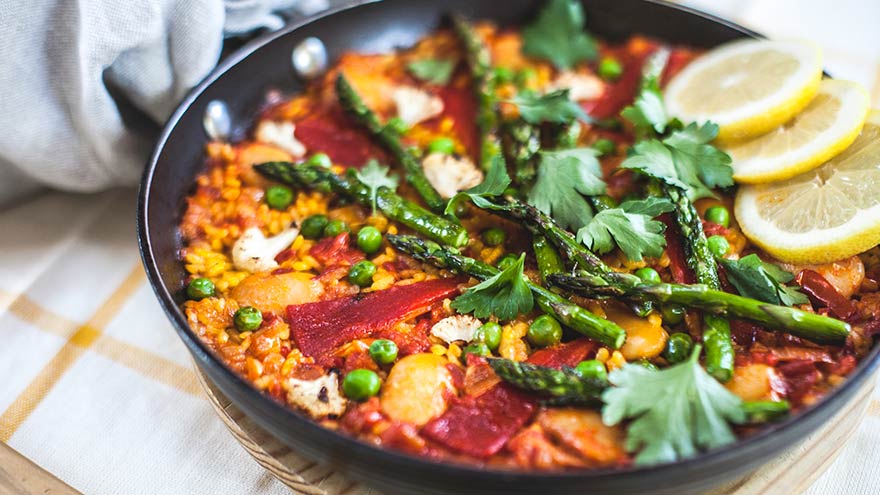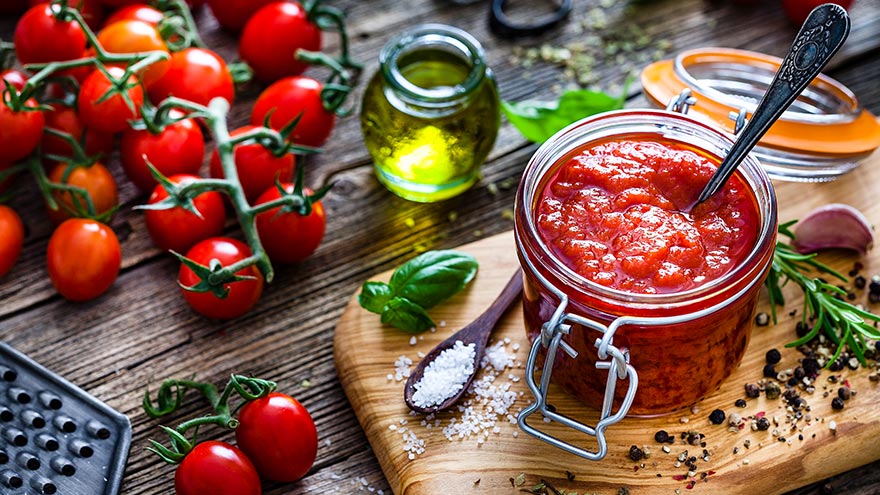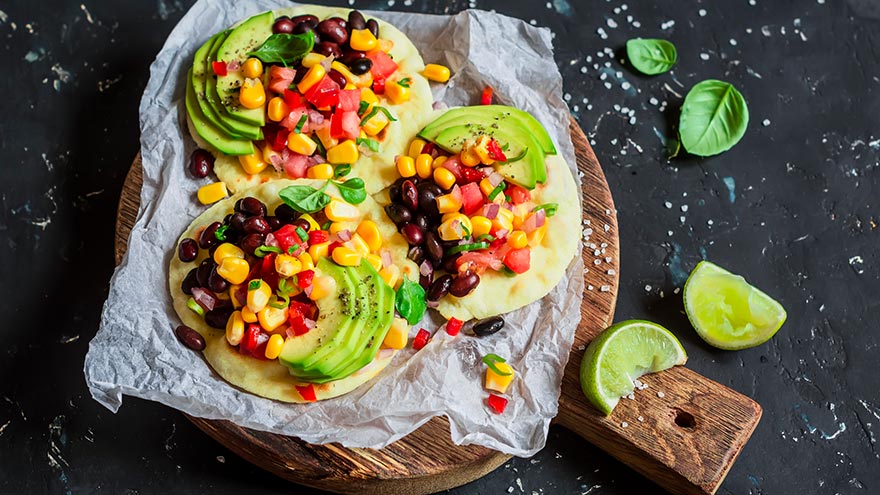Search
-
Get Spicy! Try This Easy Heart-Healthy Vegan Paella
Enjoy the heartiness of traditional paella without any added salt or meat. This recipe is also low in fat, making it a good heart-healthy choice for lowering cholesterol and blood pressure.
Read More About Get Spicy! Try This Easy Heart-Healthy Vegan Paella
-
Make Your Own Trail Mix: 4 Quick and Easy Recipes
Craving a snack with crunch, sweet flavor and a powerful nutritious punch? These healthy, homemade variants of this make-it-and-take-it super snack are sure to satisfy your sweet tooth and your healthy lifestyle. Who says healthy snacks and bland taste go together? We say you can have it all — nutritious and delicious snack foods that taste great and satisfy — and trail mix fits the bill. Your homemade batch can be as healthy as you like. The nuts provide fiber, protein and a whole lot of crunchy goodness; dried fruit and touches of chocolate infuse the mix with just the right amount of sweetness. We’ve compiled some simple-to-make and hard-to-resist recipes so you can easily pick up a few items from the grocery store’s bulk bins, or your kitchen cupboard, and put together a snack for your kiddos lunches or the office. Better yet, grab your mix and head out for a stroll or hike, or take along on your next road trip or adventure in Nevada’s rugged, desert locales.
Read More About Make Your Own Trail Mix: 4 Quick and Easy Recipes
-
3D vs Whole Breast Ultrasound Which is Right for You
Breast cancer is the leading cause of cancer deaths in women in the U.S. That’s why early detection is so important. Dr. George Krakora, a radiologist with Renown Institute for Cancer, explains what to watch for and how new technology can lead to early detection. Most women know the importance of breast health and staying current with annual breast exams, but may not know that both screening guidelines and technology is evolving. So we asked George Krakora, MD, a radiologist for the Renown Institute for Cancer, what every woman should know about breast cancer detection and which screening method is right for them. First off, when should women start getting breast exams? Generally, women should start getting breast exams using mammography or ultrasound after they turn 40 years old. But we also want women ages 18 to 39 to talk to their primary care provider and ask for what’s called a formal risk assessment to see if screening is needed sooner. And you want to make sure your care provider is giving you a breast exam starting at age 25. It’s also a good idea to be familiar with how your breasts look and feel so you can report any changes to your care provider. What are the risk factors for breast cancer? Are there any preventive steps women can take? There a few risk factors you can’t control, like your age, family history of breast or other cancers, and if you have dense breast tissue. Your risk for breast cancer increases as you get older, and most breast cancers are diagnosed after age 50. Knowing your family history is important because a history of cancer and shared lifestyle can raise your risk. Your breast density can also increase your risk: Women with high breast density are four-to-five times more likely to get breast cancer than women with low breast density. But the good news is there are quite a few things you can do to prevent breast cancer, like not smoking, watching your alcohol intake, and maintaining a healthy weight with good diet and exercise. There are a lot of newer screenings out today. What is the difference between 2-D and 3-D mammography? In a 2-D mammogram, the tech takes X-rays of the breast. These pictures can show the radiologist if there are any lumps or tumors you might not be able to feel. In 3-D mammography, the process is largely the same but more X-rays are taken and it takes a few seconds longer for each image. This kind of exam detects 41 percent more cancers and reduces the number of false-positive results given to patients. This improvement in technology is great for both patients and their care providers. 3-D mammography provides better images of the breast, which allow doctors to more clearly diagnose and avoid false positives, especially in women with dense breast tissue. And what about a whole breast ultrasound. What is that? A whole breast ultrasound uses sound waves to detect cancerous tumors in the breast without using any radiation — it’s an ultrasound just like pregnant women get to check up on their baby. And the exam only takes about 20 minutes. We recommend these exams for patients whose mammograms have shown that they have dense breast tissue. Dense breast tissue can make it harder for doctors to see any abnormalities, lumps or tumors in a mammogram, so this technology ensures better early detection.
Read More About 3D vs Whole Breast Ultrasound Which is Right for You
-
Slow Cooker Paleo Chili
Nothing says comfort like a bowl of chili. This rich, flavorful dish is Paleo-diet friendly and ready to eat when you are.
-
Paleo Garlic Mashed No-Tatoes
This scrumptious mashed potato substitute is super easy, tasty and gluten-free.
-
DIY Heart-Healthy Marinara Sauce
The convenience of marinara sauce in a jar is pretty hard to beat. But with some extra time in the kitchen, the nutritional value of traditional sauce — already packed with good stuff — goes off the charts.
-
Meatless Monday: Black Bean Tostadas
Research shows that plant-based diets can help manage — and in some cases aid — in the prevention of many chronic conditions such as diabetes, heart disease and even cancer. If you’re looking to adopt a healthier lifestyle, try incorporating more plant-based and meatless recipes into your diet — even if it’s just once a week. If you want to cut back on meat but not flavor, we’ve got you covered with this black bean tostada recipe. The list of ingredients includes a number of veggies and spices that are not only good for you, but will make your taste buds sing. The best part? This delicious, Mexican-style dish is so easy that even the most novice cook can have dinner served in just 15 minutes. Enjoy!
-
What is a High-Risk Pregnancy?
You can still have a healthy pregnancy and baby if your pregnancy is high-risk. Learn what steps you can take to give your baby the best start possible. A “high-risk” pregnancy is one that threatens the health or life of the mother or her fetus. Women with high-risk pregnancies should receive care health care specialists to ensure the best possible outcomes. Some examples of a high-risk pregnancy include: Maternal age, women 35 and higher or 17 and younger Lifestyle choices, including smoking, drinking alcohol and illegal controlled substances Existing medical history, chronic hypertension, diabetes and breathing issues Multiple gestation, pregnancy with twins or triplets Overweight and underweight Remember: You can still have a healthy pregnancy and baby if your pregnancy is high-risk. Some ways to promote a healthy pregnancy: Schedule an appointment with your OBGYN Eat a balanced diet Avoid substances Prenatal care Healthy weight gain Reduce stress Exercise Pregnancy & Childbirth at Renown | 775-982-KIDS (5437) When you are expecting a new baby, you can depend on Renown Children’s Hospital for all your mom and baby healthcare needs. We can help you find the right doctor and tell you what to expect during your stay. We offer childbirth education classes and tours to help you prepare. Be sure to check out our virtual tours of our Labor Assessment Area.
-
Super Easy Seared Salmon & Spring Salad
Watch Renown Chef Chris Wyatt blend zest and spice in this seared salmon and grilled veggie dish with a few secret ingredients. Are you looking for a new twist on an old stand-by dinner favorite while getting a heart-healthy dose of omega-3s? Look no further: Salmon recipes don’t get any easier than this. With this mouth watering recipe totaling in at just less than 350 calories, done in nearly 30 minutes, you’re going to want to make it your next meal. Added perk: Eating fish, such as salmon, twice a week has been found to lower the risk of heart attack and stroke over fish oil supplements.
-
You're Ready to Start a Family! Now What?
Deciding you’re ready to start a family is a big decision for any couple. So once you’ve decided – what are the next steps for both moms and dads-to-be? And what should you know if you’re struggling to conceive? Dr. Myron Bethel, OB/GYN with Renown Women’s Health, offers key insights about fertility. What’s the first thing couples should do when they decide to start a family? For the mom-to-be, it’s important to meet with your obstetrician before you get pregnant. This appointment gives you an opportunity to discuss your family medical history, any past or current health problems, immunization history, medications you’re taking and any issues with previous pregnancies. Your doctor can also provide helpful tips to ensure your body is ready for a healthy pregnancy and help guide you on how to monitor your period, basal resting body temperature and other important factors to help you get pregnant more quickly. How can couples who are trying to get pregnant make sure they’re healthy to conceive? Of course it’s important to maintain a healthy lifestyle all the time, but it’s especially important if you’re trying to get pregnant. There’s no magic pill or single food, but women should start focusing on nutrients they’ll need during pregnancy. Before trying to conceive, start taking folate and folic acid to help prevent birth defects. You can get good sources of these nutrients from cereal, spinach, beans, asparagus, oranges and peanuts. Lifestyle changes can also help improve fertility. For both men and women, extra weight can reduce fertility. Both sexes can increase their chances of conception by not smoking, not drinking alcohol and exercising regularly. And for men specifically, take a daily vitamin containing zinc and selenium to support healthy sperm. What is the average timeline for conception, and what do you suggest for couples who may be struggling to conceive and start a family? First, remember getting pregnant can take longer than you expect. Do not to get stressed out about it or place blame. Seventy percent of couples conceive within six months and 85 percent within one year of trying to get pregnant. To help improve your chances of pregnancy, monitor your ovulation closely. You can do this by tracking your period, watching your body closely and logging symptoms, logging your basal body temperature or using ovulation kits. If you still aren’t sure when you’re ovulating, try to have sex every other day to improve your chances of conception. If you’ve been trying for nine months to a year, you can talk to your OB about options and discuss meeting with a fertility specialist.
-
Two Dads and a Newborn Adoption: "Our Experience Was Wonderful"
Watch as two dads look back on their newborn adoption process. They reminisce about discovering their newborn was on his way — and how Renown Health subsequently helped them navigate the process. During Memorial Day weekend, Chris Mulhern and his husband, Jeffrey Bodimer, learned a set of birth parents chose them to parent their unborn baby boy. After writing a letter to the birth parents, they were chosen over other applicants in a private adoption. The adoption agency took care of many details, like connecting Mulhern and Bodimer to the birth mother and dad. In fact, they could participate in nearly all the phases of the pregnancy. The mother's prenatal care and delivery took place at Renown Health, where Mulhern and Bodimer attended her appointments and took childbirth classes. "Our experience was wonderful at Renown," says Mulhern. "We thought it was absolutely incredible how nice and accepting everyone was." The Nuances of Newborn Adoption Their son, Bradley, was born via cesarean section. And the adoptive parents got to see him an hour after he came into the world. The labor and delivery nurses even helped coordinate everything between them and the birth mom. Mulhern and Bodimer stayed in a room at The Inn at Renown. The closeness of the facility on the Renown campus made it possible to feed Bradley every two hours. Incredible Nurses "They were great, the nursing staff. If we weren't sure about doing something right, about burping him right they would say 'It's okay. He's not going to blow up. He will eventually do it'," says Mulhern. The nurses also made arrangements for the two dads to participate in skin-to-skin contact with their newborn baby. Experts agree parents and babies should be in direct contact for at least the first 1–2 hours after the birth. Taking Baby Home Chris and Jeffery took Bradley home after three days at Renown. “It was the most joyful thing to be chosen as his parents, even before we met him,” says Chris.
Read More About Two Dads and a Newborn Adoption: "Our Experience Was Wonderful"
-
Low Salt, Big Flavor! Spicy Oven-Fried Chicken
Looking for a low-sodium recipe that delivers high marks for taste? Try this Heart Association-approved recipe for oven fried chicken. Diets high in sodium can increase blood pressure, putting you at greater risk for stroke. But you don’t have to trade taste for better health. Take this recipe from the American Heart and Stroke Association: With spicy cayenne, tangy dry mustard and smoky paprika, you won’t miss the salt in this lightened-up southern classic.
Read More About Low Salt, Big Flavor! Spicy Oven-Fried Chicken











